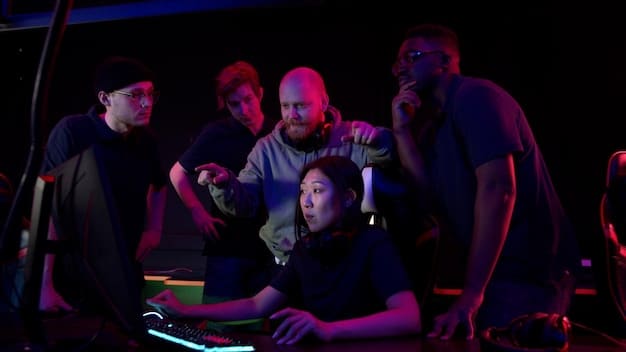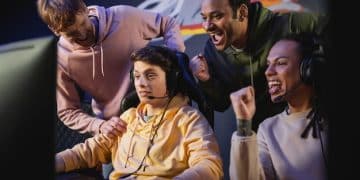Esports Visa Rules 2025: Impact on US Teams

The updated esports player visa regulations for 2025 are poised to significantly reshape how US teams recruit and manage international talent, demanding enhanced compliance and strategic foresight to maintain competitive rosters.
As the competitive landscape of professional gaming continues its meteoric rise, so too does the complexity surrounding the international movement of its star players. The question of How Will the Updated Esports Player Visa Regulations Impact US Teams in 2025? looms large, demanding a comprehensive understanding from team owners, managers, and aspiring professionals alike.
Understanding the Shifting Sands of Immigration for Esports
The realm of professional esports, once a fringe pursuit, has transformed into a multi-billion dollar industry that rivals traditional sports in viewership and prize pools. This growth has inevitably brought increased scrutiny from governmental bodies, particularly concerning international talent mobility. For US-based esports organizations, navigating the intricacies of immigration law for their foreign players has always been a significant hurdle, but 2025 promises a refined set of challenges and opportunities.
For years, the P-1 visa, traditionally reserved for “internationally recognized athletes,” has been the primary vehicle for esports players entering the US. While conceptually fitting, its application to professional gamers has been a constant point of contention and adaptation. The classification sometimes feels like shoehorning a modern phenomenon into an antiquated legal framework. The updates slated for 2025 are not necessarily an overhaul of the entire immigration system but rather a tightening of evidentiary requirements and a clearer delineation of what constitutes “international recognition” within the esports context.
The Evolving Definition of “Athlete” in Esports
Defining “athlete” in a digital sport can be challenging for legal systems designed around physical prowess. The updated regulations aim to provide clearer guidelines, which might include specific criteria such as:
- Consistent top-tier tournament placements.
- Significant prize earnings over a defined period.
- Official recognition from major esports governing bodies.
- Endorsement deals consistent with professional athlete status.
These new definitions mean that casual players, even those with significant followings, will find it harder to qualify. The focus is shifting to verifiable, quantifiable achievements that demonstrate a professional esports career, not just popularity or streaming success.
Increased Scrutiny and Compliance
US Citizenship and Immigration Services (USCIS) and Department of Labor (DOL) will likely adopt a more stringent approach to evidence submission. This translates to increased requests for evidence (RFEs) and potentially longer processing times. Teams will need to be meticulous in their documentation, providing concrete proof of a player’s standing, their team’s financial stability, and the legitimacy of the esports organization itself. This includes audited financial statements, comprehensive team rosters, and detailed competition schedules. The era of loose interpretations is drawing to a close, replaced by a demand for rigorous, evidence-based applications.
Direct Impacts on US Esports Teams’ Recruitment Strategies
The forthcoming visa regulations will force US esports teams to re-evaluate their talent acquisition processes. No longer can they solely rely on raw skill or potential; the immigration viability of a prospective international player will become as critical as their in-game performance.
Prioritizing Proven Talent
With stricter criteria for “internationally recognized” athletes, teams will naturally gravitate towards players with established careers. This means less risk-taking on emerging international talents who haven’t yet amassed a considerable competitive history. The uncertainty and cost associated with securing a visa for an unproven player will likely outweigh the potential benefits for many organizations. This could lead to a consolidation of top-tier talent among established teams, making it even harder for newer organizations to break into the elite.
Fostering Domestic Talent Pipelines
The challenges surrounding international visas will underscore the importance of developing homegrown talent. US teams may invest more heavily in scouting and nurturing players within domestic leagues and collegiate esports programs. This shift could lead to a more robust domestic esports ecosystem, providing clearer pathways for American players to reach professional ranks without immigration hurdles. It’s a pragmatic response to a tightening global talent market.
Increased Operational Costs
The added complexity of visa applications will inevitably lead to higher operational costs for teams. This includes:
- Increased legal fees for immigration attorneys.
- Costs associated with accumulating and verifying extensive documentation.
- Potential expenses for temporary alternative housing or training if players face delays.
These financial burdens could disproportionately affect smaller or newer esports organizations, widening the gap between well-funded, established teams and those operating on tighter budgets. The compliance burden is not just administrative; it’s a significant financial outlay.
Operational and Strategic Adjustments for Organizations
Beyond recruitment, US esports organizations must implement significant operational and strategic adjustments to align with the updated visa landscape. Proactive planning and robust internal processes will be paramount for success.
Early Planning and Application
The days of last-minute visa applications are over. Teams must initiate the visa process much earlier, accounting for potentially longer processing times and RFEs. This means identifying international talent well in advance of competitive seasons and building extensive compliance timelines into their operational calendars. A delay in a player’s visa could lead to roster instability, missed competitive opportunities, and significant financial losses. This requires a dedicated approach to timeline management and proactive engagement with legal counsel.
Enhanced Legal and Compliance Departments
Many esports organizations, particularly smaller ones, may have previously treated immigration as an ad-hoc legal task. The 2025 regulations necessitate a more formalized approach. This could mean hiring dedicated in-house immigration specialists or retaining highly experienced external legal counsel on a retainer basis. These professionals will be crucial in ensuring all documentation is comprehensive, accurate, and compliant with the latest guidelines. The investment in legal expertise will be a competitive advantage.

Building More Flexible Rosters
To mitigate risks associated with visa delays or denials, teams might adopt a more flexible roster strategy. This could involve:
- Maintaining larger active rosters to have backup players.
- Cross-training players for multiple roles.
- Investing in players with dual citizenship or existing US work authorization.
Such strategies provide a safety net, ensuring that competitive integrity is maintained even if key international players face unforeseen immigration challenges. It’s about building resilience into the team structure.
Potential Consequences for the Competitive Landscape
The adjustments forced by new visa regulations will inevitably ripple through the competitive landscape of US esports, potentially altering dynamics and power structures.
Increased Focus on Domestic Leagues for Talent Sourcing
As international talent becomes more challenging to secure, domestic leagues and collegiate esports programs within the US are likely to gain enhanced importance. These platforms will serve as vital proving grounds and recruitment pools for US teams seeking to nurture local talent. This could lead to a stronger foundation for professional esports within the US as organizations prioritize developing their own talent pipelines rather than relying solely on global imports. The shift could redefine career paths for aspiring American players.
Shift in Player Valuation and Compensation
The scarcity of easily accessible international talent, combined with the increased costs of securing their visas, could influence player valuation. Proven international players who successfully navigate the visa process might command higher salaries and better benefits due to their relative scarcity and the investment required to bring them in. Conversely, domestic players could also see their value increase as teams seek to avoid immigration complications entirely. This dynamic could lead to a re-calibration of the esports player market.
Impact on Team Diversity and Global Appeal
A natural consequence of stricter regulations could be a reduction in the diversity of nationalities on US-based rosters. While some teams will continue to recruit globally, the administrative and financial hurdles may lead others to prioritize players from countries with simpler visa agreements or those who already hold US work authorization. This might impact the global appeal of some US-based teams if they become less representative of the international esports community. However, it could also foster regional rivalries and enhance the local fan base.
Case Studies and Precedent: Learning from Other Sports
Esports can draw valuable lessons from traditional sports leagues that have long navigated complex international athlete visas. The paths forged by leagues like the NBA, NHL, and MLS provide blueprints for managing global talent effectively.
The NBA Model: Global Scouting and Extensive Support
The National Basketball Association (NBA) is a prime example of a league that thrives on international talent. They invest heavily in global scouting networks and have sophisticated legal and administrative teams dedicated to player visas. Their model emphasizes long-term player development and robust support systems, including dedicated immigration lawyers, cultural assimilation programs, and even family support. This proactive approach ensures that top global talent can seamlessly integrate into US teams.
They also have established pathways for youth players, like the G-League, which act as a filter and development ground. If esports aims for similar global reach, it must emulate such comprehensive support infrastructure. The NBA’s model highlights that bringing in international talent is more than just securing a visa; it’s about holistic integration.
Challenges Faced by Emerging Leagues
Newer or smaller traditional sports leagues, much like many esports organizations, often face greater challenges. They may lack the resources of an NBA to provide extensive legal support, leading to more frequent visa issues or an inability to attract top-tier international players. This underscores the need for esports organizations to budget and plan for dedicated immigration resources, rather than viewing it as a secondary concern. The experience of these leagues shows that under-resourcing immigration can directly impact competitive quality.
Lessons for Esports: Proactive Engagement and Advocacy
One crucial lesson is the importance of proactive engagement with government bodies. Traditional sports leagues often lobby for favorable visa conditions and work closely with immigration authorities to streamline processes for their athletes. Esports organizations, collectively, may need to strengthen their advocacy efforts to influence future policy and ensure that the unique nature of professional gaming is better understood and accommodated within immigration frameworks. This collective voice can be powerful in shaping policy.
The Role of Technology and Digital Solutions
In a digital-first industry like esports, technology will undoubtedly play a crucial role in streamlining processes and managing the increased administrative burden introduced by updated visa regulations.
Digital Documentation and Management Systems
Teams and immigration lawyers will increasingly rely on advanced digital platforms for document management, submission tracking, and compliance auditing. These systems can help organize the vast amount of evidence required for visa applications, ensuring nothing is missed and submissions are timely. Features like automated reminders for deadlines and digital checklists will become indispensable. This shift moves away from paper-heavy processes, enhancing efficiency and accuracy.
AI-Powered Compliance Tools
Artificial intelligence could be leveraged to assist in preliminary eligibility assessments, analyzing a player’s competitive history and achievements against updated visa criteria. While AI won’t replace human lawyers, it can significantly speed up the initial vetting process, flagging potential issues before a full application is prepare. This enhances efficiency and reduces overall processing time for teams. AI could also help identify patterns in successful visa applications.
Remote Work and Training Solutions
While not directly related to visa acquisition, the possibility of remote work and training from players’ home countries could become a more strategic consideration, especially during prolonged visa processing delays. Technology enables this flexibility, ensuring players remain engaged and practice schedules are minimally disrupted even if they are not physically present in the US. This offers a safety valve for teams dealing with extended visa timelines.

Looking Ahead: The Future Landscape for US Esports
The updated visa regulations for 2025, while undoubtedly presenting challenges, will also catalyze significant evolution within US esports. Adaptability, foresight, and strategic investment will define success.
Increased Professionalization of Esports Operations
The necessity for robust legal, human resources, and administrative functions to manage international talent will elevate the overall level of professionalism within esports organizations. This will mirror the operational sophistication seen in traditional sports, leading to better-managed teams and more stable careers for players. Esports is growing up and adopting best practices from established industries.
Stronger Domestic Player Development
The emphasis on fostering US-based talent will likely lead to a stronger domestic competitive scene. More investment in grassroots initiatives, collegiate programs, and regional leagues will create clearer pathways for American players, potentially reducing the reliance on international imports over time. This internal growth is crucial for long-term sustainability.
A More Resilient and Compliant Industry
Ultimately, the tightened regulations will push US esports towards a more compliant and resilient operational model. While initially demanding, these changes aim to legitimize esports further in the eyes of governmental bodies and the public. A more formally structured industry is better positioned for sustained growth and global recognition, ensuring that the spectacle of professional gaming continues to captivate audiences worldwide. The challenges of 2025 are, in essence, growing pains for a maturing industry.
| Key Impact | Brief Description |
|---|---|
| 📊 Stricter Eligibility | Clearer, more stringent criteria for “internationally recognized athletes,” requiring concrete competitive evidence. |
| 💼 Higher Operational Costs | Increased legal fees, documentation expenses, and potential for delays will raise financial burdens on teams. |
| 🇺🇸 Domestic Talent Focus | Teams will invest more in US-based players and development pipelines to mitigate visa complexities. |
| ⏱️ Early Planning Vital | Proactive and early application processes become essential to avoid roster disruptions and competitive setbacks. |
Frequently Asked Questions About Esports Visas in 2025
▼
The primary visa type for internationally recognized esports players in the US is typically the P-1 visa. This classification is generally granted to athletes and entertainers who demonstrate a high level of achievement and recognition in their field. The updated regulations aim to clarify and strengthen the criteria for what constitutes “internationally recognized” within the esports context for P-1 eligibility.
▼
Yes, it’s likely to become more challenging for emerging international talents. The updated regulations emphasize a need for stronger evidence of “international recognition,” which typically includes consistent top-tier competitive results, significant prize earnings, and official recognition from major esports bodies. This shift favors established players with a proven professional track record over those just starting their careers.
▼
Smaller US esports organizations may face disproportionate challenges. Increased legal fees, the need for more extensive documentation, and longer processing times will elevate operational costs. This could make it harder for them to compete with larger, more well-funded teams in acquiring and retaining international talent, potentially leading to a greater focus on developing domestic player pipelines.
▼
To adapt, US teams should prioritize early visa application planning, build more flexible rosters, and consider investing in dedicated legal and compliance expertise. Fostering domestic talent development and exploring technological solutions for document management can also help streamline processes and mitigate risks associated with international player recruitment and retention.
▼
There’s a potential for reduced diversity in national origins on US-based rosters, at least initially. As the process of securing visas for international players becomes more complex and costly, some teams may opt to prioritize domestic talent or players from regions with simpler immigration agreements. However, top-tier teams will likely continue to invest in global scouting to maintain a competitive edge, fostering diversity at the elite level.
Conclusion
The approaching 2025 visa regulations signal a new era for US esports, one demanding greater strategic planning, meticulous compliance, and an elevated level of operational professionalism. While the landscape may become more challenging for the recruitment of international talent, these changes are poised to foster a more robust domestic ecosystem and push the industry towards a more mature and resilient future. Teams that embrace these adjustments proactively will be best positioned to thrive in the evolving competitive arena.





